- Why Mining Matters
- Jobs
- Safety
- Environment & Operations
- FAQ
- Links
- Fun Stuff

Mining and quarrying have a long and proud history of helping build our province. Materials extracted locally have been used to build our infrastructure both in centuries past and today.
Here are some examples of well-known Nova Scotia infrastructure – buildings, bridges and roads – that the mining industry has helped build.
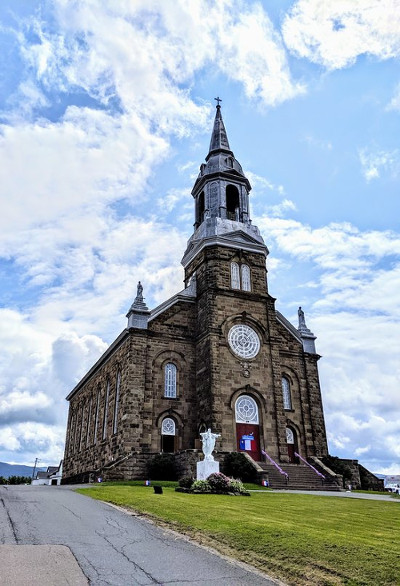
St. Peter’s Church, Cheticamp
Mining built Nova Scotia!
St. Peter's Church in Cheticamp is one of only a few stone churches in Cape Breton. It was built of sandstone from Cheticamp Island that was pulled across the frozen harbour to the church site. Here’s the story:
Roman Catholic priest Pierre Fiset (1840-1909) was transferred to Cheticamp in 1875. Father Fiset believed in improving peoples’ lives, not just tending to their souls. He opened several businesses as part of his efforts to create jobs and improve the standard of living for his parishioners.
He purchased a general store in 1883 to give local fishermen an alternative to the company store run by the Robin Company, which established a fishing station at Cheticamp Island in 1767.
In 1884 Fiset requested a provincial government subsidy for a ferry service between Pictou and Chéticamp which would link the community to a railway and better markets. Regular service was established two years later.
To provide better facilities for local fishermen, he had a large wharf built at Cheticamp harbour in 1888 and another elsewhere in 1904. He purchased a lobster cannery on Cheticamp Island from the Robin Company in 1896.
As an example to his parishioners, many of whom were also subsistence farmers, Fiset operated a large farm, with five barns, eight horses, and over 100 head of cattle. The grist-mill he acquired also became a profitable venture.
Fiset also started the Cheticamp gypsum quarry in 1907. He founded the Great Northern Mining Company to operate the quarry and served as the company’s president. Today the former quarry, pictured below, is a beautiful swimming hole and hiking trail. (See the history of the quarry at https://notyourgrandfathersmining.ca/cheticamp)
While all these works played an important role in improving the standard of living of his flock, Fiset also believed that a proper church was required. Construction on St. Peter’s (aka Paroisse Saint-Pierre) started early in 1892 and the first mass was celebrated on December 18, 1893.
The sandstone exterior of the church came from the northern end of Cheticamp Island and was donated by the Robin Company. The stone was quarried and then hauled across the frozen harbour.
The Cheticamp Island quarry was one of a number of small quarries in western Cape Breton that provided sandstone for local use in places like Southwest Margaree, Broad Cove, Whycocomagh, Southwest Mabou and Pleasant Bay. For example, sandstone was quarried from a local beach at McKays Point to build Judique’s St. Andrews Church.
When St. Peter’s was partially built, an older stone church at nearby Le Buttereau, which was built in 1868, was torn down and its stone was also used in St. Peter’s.
Parishioners donated money, wood, mortar and their labour to the building of St. Peter’s Church.
St. Peter’s is one of the finest examples of a style of church architecture developed in Quebec which is rarely seen outside that province. With its tall silver spire and steeply pitched roof, it resembles many other Catholic churches built along the St. Lawrence River.
Father Fiset, a transformative figure in Cheticamp’s history, is buried in a crypt beneath St. Peter’s.
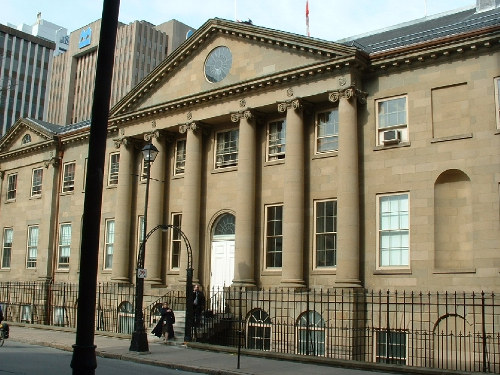
Nova Scotia's Legislature
Nova Scotia’s legislature met in several different places in its early days. In October 1758, it met in the courthouse at the corner of Argyle and Buckingham Streets, which is the current site of Scotia Square Mall. In winter 1758-59, it met at Walter Manning’s. It is unclear where it met from 1759-64, but it may have continued to meet at Mr. Manning’s. From 1765-89 it met at the Old Halifax Grammar School Building, on the northwest corner of Barrington and Sackville Streets. From 1789–1819, it met in Cochran’s Building, the present site of the Art Gallery of Nova Scotia on the southeast corner of Hollis and George Streets.
Plans to build a permanent legislature, what we now call Province House, were discussed as early as the 1780s. However, building it was delayed when Lieutenant Governor Sir John Wentworth demanded that a new Government House – a residence and office for him – be built. Government House’s construction started in September 1800 but its budget ran way over, from an estimated £10,500 to £30,000, placing a great strain on the colony, which only had 60,000 people at the time. Wentworth even took the land that had originally been purchased for the legislature, at the corner of Spring Garden Road and Barrington St.
Construction of the legislature finally began in 1811 on the site of the first governor’s residence in Halifax. The legislature opened in in 1819.
The building’s foundation is ironstone from the Dalhousie quarry on the Northwest Arm. The stone is 480 million years old and was a common building material in Halifax in the 1800s. It can still be seen in the Morse’s Tea building and others around Historic Properties. It oxidizes/rusts due to its high iron content. This can be seen in the pictures below from the legislature’s basement.
The legislature's exterior walls are tan sandstone from the Batte quarry in Wallace, Nova Scotia. The stone is 300 million years old and about 100,000 blocks of it were used. The legislature's exterior walls are up to 3 metres thick.
In 1985 the legislature was renovated. The Wallace sandstone was cleaned to its original colour so it could be inspected. 1700 stones were replaced with stones from the same quarry so they would match.
The legislature has flooring of marble and limestone, stones that are made of the shells and bones of sea creatures. When these animals die, their shells and skeletal debris accumulate as sediment at the bottom of bodies of water and are eventually turned into rock (limestone, chalk and marble) by heat and pressure. This process often creates fossils which can be seen in the legislature's floors.
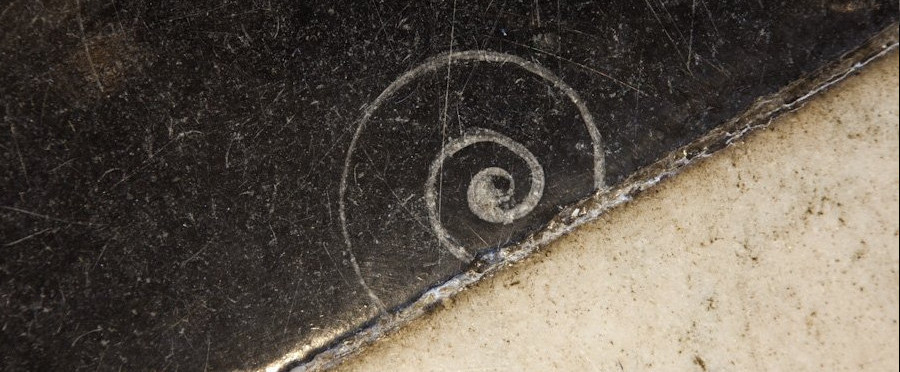
The 1811 legislation that approved and funded the building of the legislature specified that Halifax painter and glazer, John Merrick, would design it. However, there is some question about whether Merrick designed the building or just used his business connections with the British to buy a design. Merrick is not known to have designed any other buildings and the legislature would have been quite an undertaking for a novice architect.
Merrick’s design for the legislature was chosen over that of master builder Richard Scott, who was chosen to oversee the construction of the legislature. An 1826 article in the Acadian Magazine said that Scott was the true architect, but no one knows for sure.
The Provincial Building, built in 1935, is immediately across Hollis Street from the legislature. The Provincial Building copied the legislature’s architecture for the sake of continuity – they are both made of sandstone from Wallace and have similar features – but an important difference between them is that the Provincial Building was built with granite courses at ground level because granite does not absorb or wick water, as sandstone can. The legislature has sandstone, which is porous, at ground level, but most buildings built after 1820 used courses of non-porous stone at ground level to prevent moisture problems.

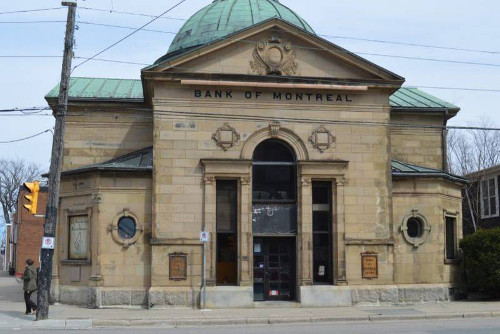
Bank of Montreal, Sydney
The old Bank of Montreal building in Sydney was built between 1900-01. It was made of sandstone from Wallace, Nova Scotia, the area that provided stone for so many historic buildings, including our legislature and parts of the parliament buildings in Ottawa.
The bank was built because of the economic boom that occurred in Sydney in that era. Large steel plants located in Sydney, fed by nearby coal mines, made Sydney a hub of commercial and industrial activity.
The building was designed by renowned architect Sir Andrew Taylor of Taylor and Gordon. Its Palladian windows, copper dome, columns, and pediments combine to make a striking building and is one of the best examples of commercial Neo-classic architecture in the province.
It was built on one of the few lots left in Sydney’s bustling downtown core by Rhodes and Curry Company, the largest construction company in the Maritimes from 1880 until 1920. Rhodes and Curry was founded in 1876 by Nelson A. Rhodes and Nathaniel A. Curry, brothers-in-law in Amherst. Initially, they opened a door and sash factory, which burned down, was rebuilt and burnt again. After obtaining long-term financing, they diversified into construction and building railcars with the purchase of the James Harris Car Company in Saint John. To maximize profits, the company acquired timber lands, sawmills, lime deposits and brickyards, so they could use their own materials and build everything from the foundations to roofs of buildings.
Rhodes and Curry built thousands of homes and buildings in the Maritimes, including Halifax’s city hall, Sydney’s St. Andrew’s United Church (now the Highland Arts Theatre) and stations, offices, and roundhouses for the Intercolonial Railway including Pugwash’s train station. They built much of historic Amherst, including its courthouse, armoury and hospital. They also built hundreds of company houses for coal miners in New Glasgow and Sydney.
The Bank of Montreal’s construction was supervised by James Reid of North Sydney. Dan Gillis from Portage was also a foreman.
According to the Old Sydney Society (www.oldsydneysociety.org), which is based in the building today, when an extension was added in the 1970s, it was built with concrete blocks. However, the blocks of sandstone from the exterior wall that was taken down for the extension were split into two or three slices and used as the facade for the addition so the building’s look would be maintained.
New Glasgow Town Hall
New Glasgow town hall was built 1884-1887 of sandstone from Mckeens Quarry in Pictou County - at a cost of $43,285.61! It was commissioned by Prime Minister Sir John A. MacDonald, one of 78 Post Offices/Custom Houses he built across Canada. It was also briefly the town's courthouse.
The town bought the building in 1957.
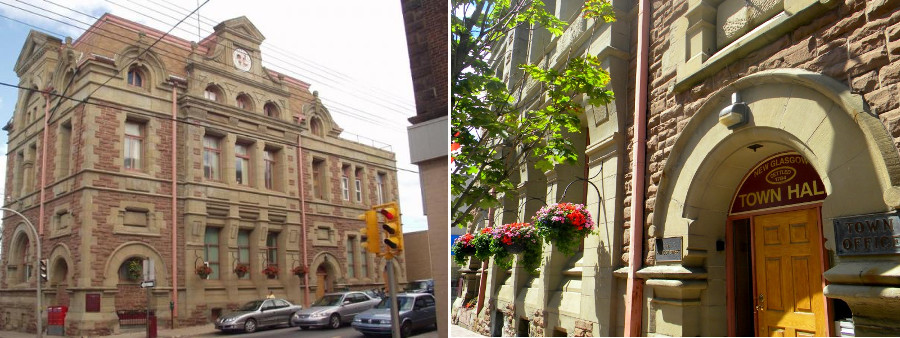
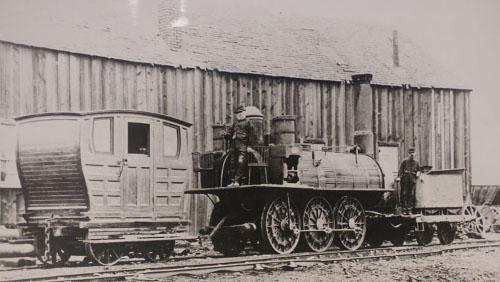
Albion Mines Railroad
Many Nova Scotia mines and quarries in the 1800s used tramways (horse-drawn wagons on rails) to transport rock. They were ancestors to our first railways because they showed the advantage of steel rails (instead of wood) and gave a platform for early locomotive experiments.
Nova Scotia's first railway (meaning it was powered by steam, not horses) was the Albion Mines Railway in Stellarton, built in 1839 to haul coal from the Stellarton mines to docks in Pictou Harbour. It was only the second steam railway in Canada. It operated until 1961.
Samson, the oldest locomotive in Canada, was one of the "iron horses" imported from England in 1839 to haul Albion Mines trains. Retired in 1883, it was displayed at Chicago's World Fair, in Baltimore, Halifax and New Glasgow. Today it's at the Stellarton Museum of Industry.
Stellarton used to be named Albion Mines, the name given to it by the General Mining Association, an English mining company that created the town in the 1820s. GMA brought the industrial revolution to NS with its skill, steam engines, pumping equipment and machinery.
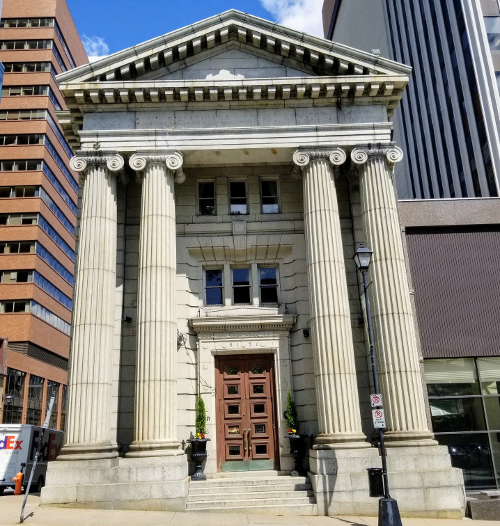
Bank of Commerce Building
The Bank of Commerce (aka Merrill Lynch) Building in Halifax was built in 1911 of granite from Terence Bay.
The stone was chosen to convey the strength and stability of a bank.
The former quarry is now part of the Terence Bay Wilderness Area.

(Left: Terence Bay Wilderness Area. Right: The Bank of Commerce (aka Merrill Lynch) Building).
St. Bernard Church
Construction on St. Bernard Church in Digby County began in 1910 and took 32 years to complete because the parish was determined not to go into debt. It's made of granite from the Shelburne Island Park Quarry which operated from 1890 to the 1960s.
The St. Bernard Church was built with over 8000 blocks of "Scotia Grey" granite shipped by rail from Shelburne to Little Brook Station, and then taken by ox cart over a gravel road to the construction site. Due to weather, this was only done 7 months per year.
The 350 million-year-old granite at the Shelburne Island Park Quarry helped build many other Nova Scotia buildings, including the Shelburne Post Office and the old Halifax Herald Building.
Today, the quarry is part of the Islands Provincial Park.

(Left: Islands Provincial Park. Right: St. Bernard Church)
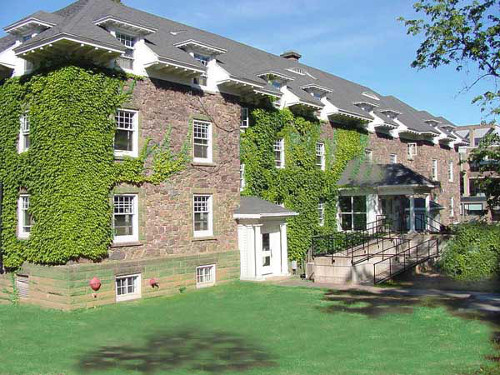
Horton House
Horton House at Acadia University opened in 1915. The lower part of the building, steps, trim and chimney are sandstone from Wallace.
The upper walls are quartzite - sandstone transformed by extreme heat and pressure into new, harder rock - quarried at White Rock.
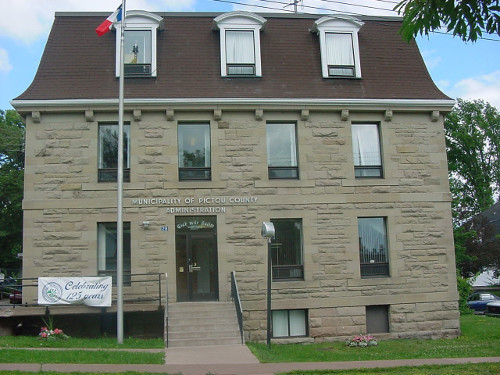
Pictou Municipal Building
The Pictou municipal building was made of sandstone from the Belleville (aka Fogo) quarry in 1891. It was originally the Pictou jail and was later renovated for use as the County seat after a fire.
There were about 75 sandstone quarries in Nova Scotia in the 1800s.
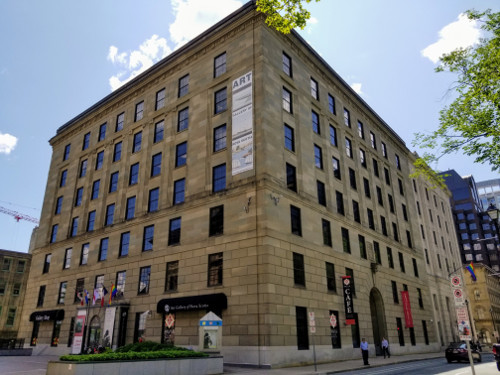
The Provincial Building
The Provincial Building on Hollis St. was completed in 1935. It's a steel and concrete frame with sandstone walls from Wallace, Nova Scotia.
Its stone and ornamental work copied that of the legislature across the street to have architectural continuity.
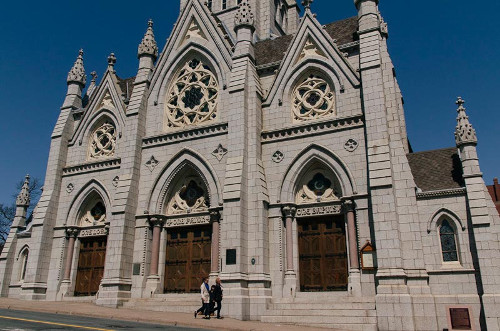
St. Mary's Cathedral Basilica
St. Mary's Cathedral Basilica in Halifax was built in the 1820s of ironstone with a sandstone facade. It was only the third masonry building in the city at the time - even the Citadel was wood until construction of the stone version started in 1828.
St. Mary's was renovated between 1860-1876 with ironstone and granite from the Dominion Quarry in Purcell's Cove. Its original spire was hit by lightning in 1867 and was replaced with what is still the highest free-standing granite spire in North America.
Dennis Building
The Dennis Building was built in 1841 of stone. Two floors and a granite facade were added in 1863. After a 1912 fire, three floors made of brick from Hantsport were added, plus steel and concrete for stability.
The building is named after William Dennis who bought it in 1901 to house the Chronicle Herald newspaper.
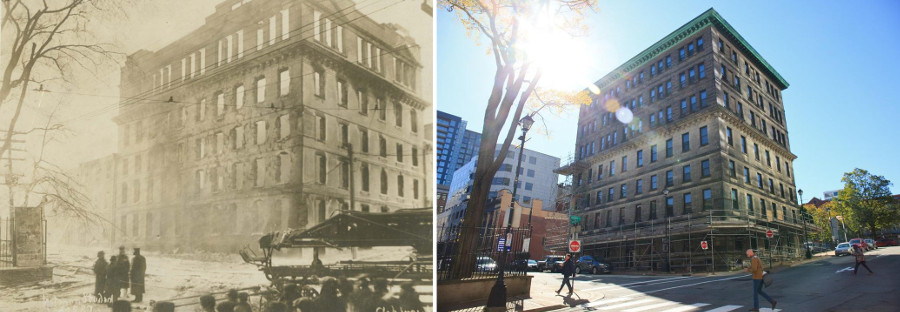
 The Wave, Halifax.
The Wave, Halifax.The Wave
The Wave on Halifax’s waterfront is made of reinforced concrete - a frame of steel (made of iron and coal) covered with wire mesh, with concrete over it. (Concrete contains limestone and aggregate).
The stone carving that says you shouldn't climb on the Wave - which everyone ignores - is granite.
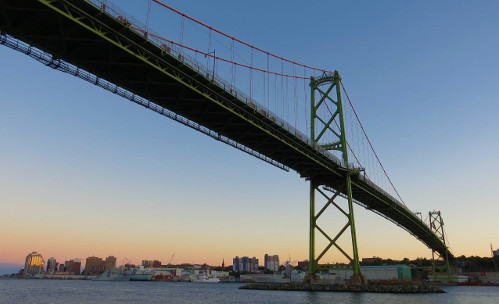 The MacDonald Bridge, Halifax.
The MacDonald Bridge, Halifax. Steel is Everywhere!
Global steel production is about 1.6 billion tonnes per year and it's everywhere - infrastructure, vehicles, machines, etc. For example, many Nova Scotia bridges are made mainly of steel.
You can't make steel without coal. Steel is iron and carbon, and the carbon is derived from coal. It takes 0.8 tonne of coal to make one tonne of steel.
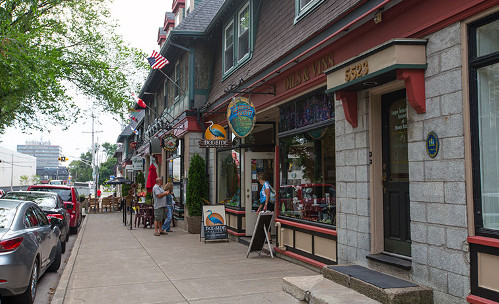
Hydrostone Neighourbourhood
The beautiful, historic Hydrostone neighbourhood in Halifax’s north end was built to provide housing after the Halifax Explosion. The explosion, which took place December 6, 1917, levelled much of Halifax and housing was in short supply. The Hydrostone was Canada’s first public housing project.
Hydrostone isn't actually stone - it's concrete block finished with crushed granite to make it look like cut stone. The blocks were manufactured in Nova Scotia’s Eastern Passage.
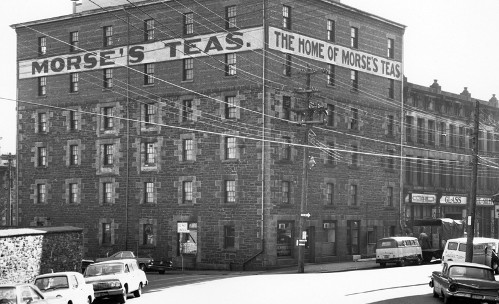
Morse’s Teas Building
The Morse's Tea building in downtown Halifax was built in 1841, mainly of ironstone quarried in Purcell's Cove with granite trim around the windows. Two stories made of brick were added following a 1927 fire and it’s easy to see how different the building materials were.
Morse's was Canada's first tea company.
Ironstone was a common building material in the 1800s in Halifax because it could be quarried locally. It was not considered the most attractive building stone, so it was often “dressed up” with granite or sandstone trim. Many buildings in the Historic Properties used these materials.
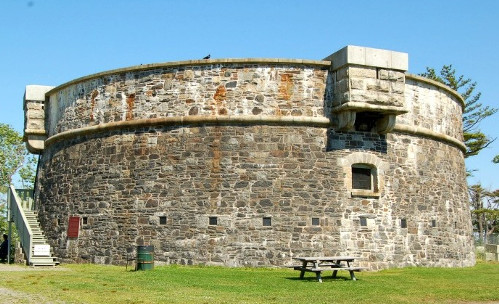
Prince of Wales Tower
Prince of Wales Tower in Halifax’s Point Pleasant Park, also known as Martello Tower, was built in 1796-99 of rubble stone (rough unhewn rocks set in mortar). Much of the stone came from the Quarry Pond and other quarries in the park. Some stone also came from quarries in Purcell’s Cove.
It was the first Martello tower in the British Empire and a key step toward adoption of a standardized Martello tower design by the British military in 1804. Almost 200 Martello towers were built by the British around their empire for coastal defence.
It was built on the park’s highest point so it overlooked Halifax harbour and it was a key part of the city’s defences. It was one of five Martello towers built in Halifax but is the only one that still stands.
Guns were mounted on the roof and the second storey of the tower, with quarters for up to 200 soldiers. From the 1860s onward the tower was used as a self-defensible depot magazine. The tower’s garrison was never called into action to defend the town and residents.
Factoid:
The Quarry Pond in Point Pleasant Park was a quarry in the late 1700s and 1800s, one of a number in the park that helped build its forts, roads and walls. It later filled with water and became the pond we know today.
Small holes were made in the slate with hand-held drills. The holes were filled with explosive to extract the rock. The stone was then shaped by hand for the buildings in which it was going to be used. Some drill holes can still be found at the pond.
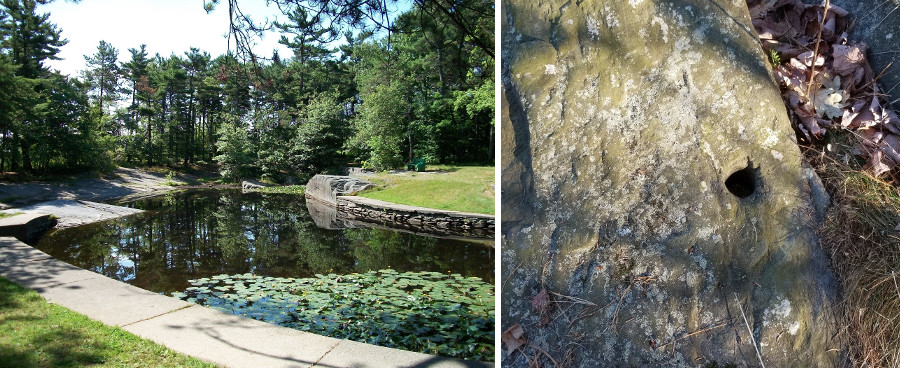 Left: Quarry pond today. Right: Hole made from hand-held drill.
Left: Quarry pond today. Right: Hole made from hand-held drill.
Aggregate
Aggregate is used in virtually all infrastructure including homes, roads, schools and hospitals. It is the main component in both concrete and ashphalt, which all modern heavy construction relies on.
Building one kilometre of highway requires 18,000 tonnes of aggregate. That’s enough to fill four Olympic-sized swimming pools. We need to extract 10-15 million tonnes of new aggregate each year to build and maintain Nova Scotia’s infrastructure.
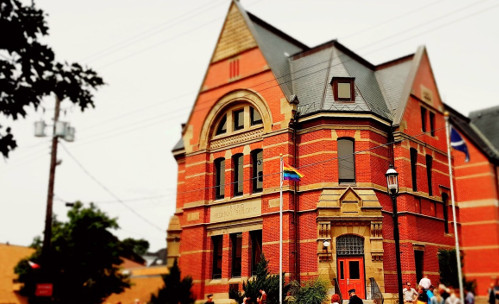
Truro Town Hall
Truro town hall was built in 1884 of brick, likely from Pugwash. Carved sandstone from Wallace adorns the entrances. The building started as Truro's post office and later served as its police station before becoming town hall.
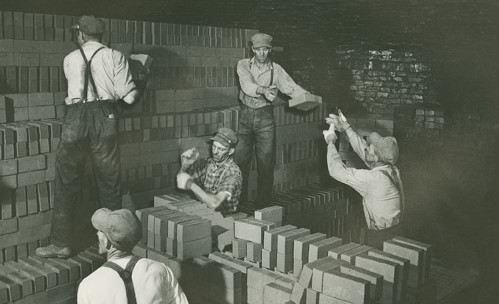
Bricks
From 1880-1937 there were brick-making plants in many Nova Scotia towns that supplied their local areas. Shaw Brick started buying small plants in the 1930s but eventually only ran plants in Chipman, New Brunswick, and two Nova Scotia towns: New Glasgow and Lantz. Lantz is one of only three brick manufacturing plants left in Canada.
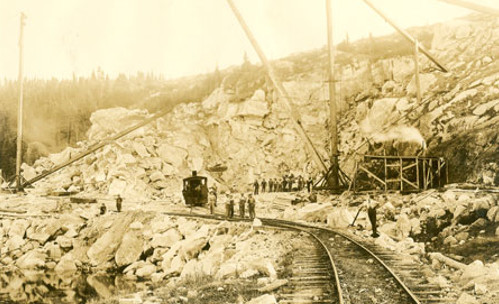
Purcell’s Cove Quarries
Purcell's Cove had several quarries between the late 1700s and the 1950s that provided granite, ironstone and slate for many important buildings in Halifax, including Citadel Hill, York Redoubt, Martello Tower, the Town Clock, Grand Parade, Dalhousie University and buildings at Historic Properties.
Today, the quarries are considered to be of significant heritage value.

Lord Nelson Hotel
The Lord Nelson Hotel in Halifax was built in 1928 of brick made by Nova Scotia company Shaw Brick in Lantz, Hants County. Its granite steps are from Queensport, Guysborough.

Old Halifax Court House
After several major fires, an 1857 Halifax bylaw required that large buildings be made of stone or brick. This gave us historic buildings like the Old Halifax Court House on Spring Garden Road, built in 1862 of sandstone from Wallace. Still standing 157 years later!
Lighthouses
For centuries, Nova Scotia’s lighthouses have greeted those who have arrived on our shores and have helped to protect those who make their living on the water. Today, there are 150 lighthouses located throughout Nova Scotia. Here are some examples.
 Cape George lighthouse
Cape George lighthouseCape George Lighthouse
Lighthouses were built at Cape George in 1861, 1908 and 1968.
The current one was built per a standard Department of Transport plan: tapered, octagonal and with reinforced-concrete.
It was a frequently-used design because it could be built with common but durable materials like aggregate.

Louisbourg Lighthouse
The Louisbourg Lighthouse, by the Fortress of Louisbourg in Cape Breton, was the first built in Canada. It was built by the French in 1734 of fieldstone, also known as rubble stone - rough, unhewn rocks set in mortar, but not laid in regular courses. The lighthouse had a slate roof.
While the tower was made of stone, the frame for the lantern was made of wood and it caught fire and was destroyed in 1736. A new lantern was built and finished in 1738. It was designed to be fireproof – it had six pillars of cut stone which supported a brick roof.
The lighthouse stood until 1758 when it was destroyed during a British attack on Louisbourg.
(After capturing the fort, the British wanted to make sure it could not be used by the French again, so miners tunneled under its defenses and set off explosives. Some of its cut stone was reused in buildings in Halifax and Sydney. For example, St. George's Church in Sydney was partly built with stone from Louisbourg. It was built between 1785 and 1791 and was Sydney's first building.)
A new lighthouse was built of wood in 1842 but it burned to the ground in 1922.
The lighthouse that stands today was built in 1923-24 and is made of concrete. Concrete is a mixture of aggregate (sand, gravel or crushed stone) and paste. Today, the paste used in most concrete is portland cement and water.
The lighthouse sits on Precambrian igneous rocks created from ash spewed into the atmosphere by volcanoes.
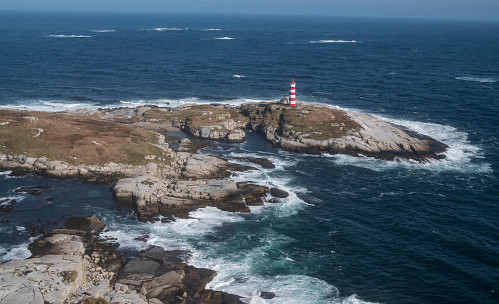 Sambro lighthouse
Sambro lighthouseSambro Lighthouse
The Sambro lighthouse at the mouth of Halifax harbour was built in 1758 as a result of an act passed by Nova Scotia's first elected government. It's the oldest working lighthouse in North America. It's built of quarried granite with wood shingles around it to protect the mortar from the elements.
Sambro Island is granite.
 Peggy's Cove lighthouse
Peggy's Cove lighthousePeggy's Cove Lighthouse
The Peggy’s Cove lighthouse was built of concrete in 1914. It is actually the second lighthouse that’s been at Peggy’s Cove. The first was a wooden house with a beacon on the roof. It was built in 1868. It was the lighthouse keeper’s home even after the new lighthouse was built. The house was damaged by Hurricane Edna in 1954 and torn down.
 Low Point Lighthouse
Low Point LighthouseLow Point Lighthouse
The first Low Point Lighthouse, in New Victoria at the mouth of Sydney harbour, was built in 1826. It was wooden with a lead roof.
The General Mining Association was given a monopoly on all mineral rights in Nova Scotia in 1826 and it increased the amount of coal being exported from Sydney, Cape Breton. The increase in shipping activity made it important to mark the entrance to Sydney harbour and to help keep ships safe.
The wooden tower was replaced in 1938 with the concrete tower that stands at the site today.
 Cape Forchu Lightstation
Cape Forchu Lightstation The real lighthouse at Cape Forchu (left) and the fake one (right)
The real lighthouse at Cape Forchu (left) and the fake one (right)Cape Forchu Lightstation
The first lighthouse at Cape Forchu was built in 1839 of wood. When it was no longer structurally sound, it was demolished and replaced in 1962 with a new tower made of concrete. The new Cape Forchu lightstation (aka the Yarmouth Light) was the first lighthouse in Canada to have an “apple core” design.
A movie called “The Lighthouse” was shot at Cape Forchu in 2018 but a fake lighthouse and other buildings were built for the set because the movie takes place in 1890. The movie lighthouse was covered with plywood and then wrapped in a thin sheet that made it look like the lighthouse was made of brick.
The rocks seen at Cape Forchu are volcanic rocks that formed off the coast of North Africa. They joined Nova Scotia through the process of continental drift.

















































































